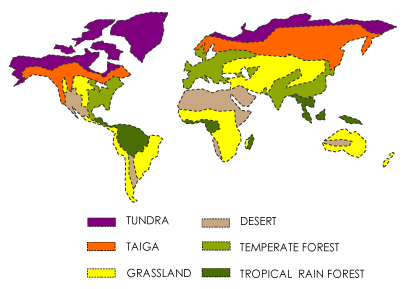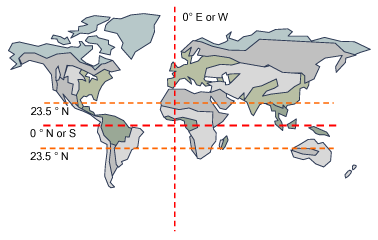
Biomes are climate zones worldwide on land and in the water that support different plants, animals, on different soils and with different temperatures, humidity, and rain. These ecological communities include the arctic tundra, the taiga, the temperate deciduous forest, the tropical rain forest, the savannah, and the desert. People also live in these different places. They build different types of shelters and communities in response to climate, culture, and topographic living conditions. The three water biomes: **arctic, freshwater, and saltwater. also support diverse life and plants. Scientists study biomes to understand their ecosystems and their changing climate, freshwater needs, and endangered species. How people interface with a specific place’s environment, wildlife, and vegetation balances or imbalances nature. Disappearing rainforests, wetlands, grasslands, and global warming in the polar ice caps are all current biotic concerns.
Identify with your biome!!
Activity 1 – Find and Define Your Biome

Find out the latitude and longitude of your neighborhood and city. Plot your location on a map. Next, look at the link to the world biome map and find the biome that you live in. Do you have seasons? What is the annual temperature range and precipitation? What plants and animals are native to your area? What are homes like? Do the homes in your area reflect a natural response to your biome? Make a picture chart of your biome that shows your house in the four seasons with temperature ranges and amounts of precipitation. Know your Eco System and become a steward of its biodiversity of life!
Activity 2 – Ring Around the World!

Print a World Map using the link. Draw the equator at zero degrees latitude. The equator is almost 25,000 miles around (24,901.55 miles or 40,075.16 kilometers). Show the sun directly overhead at noon above the equator on the two equinoxes - near March 21 and September 21 at the equator. Label the top half of the Earth the Northern Hemisphere and the bottom half the Southern Hemisphere. Next, draw the Tropic of Cancer at 23.5° North of the equator and the Tropic of Capricorn at 23.5° South of the equator. This area is known as the ‘tropics’ because the sun is always high in the sky. North of the Tropic of Cancer and south of the Tropic of Capricorn, biomes have seasons. Lastly, locate the Prime Meridian and divide the Earth into the Eastern and Western hemispheres. Post your world Biome map in the Gallery!
Activity 3 – Draw And Label A World Biome Map
Research biomes of the world. Match these Biome Flashcards. Open the World Biome map. Copy the map and label the biomes. Then draw a view of each biome. Include landforms, geography and topography features, key vegetation and plants, and at least three animals. Label your Biome pictures and include them in your journal.

Activity 4 – Home Sweet Home Biome
Exploring your local biome is a fantastic way to connect with the world around you and better understand how life works together in your community! By observing the animals, insects, plants, groundcover, and landscape, you can see the unique characteristics that make your biome special. Try taking photos of the living things you find and sorting them by type or habitat. You may even discover something you’ve never seen before! Every detail you observe tells a story about how these organisms interact and depend on each other to thrive. So, grab your camera, head outside, and see what new wonders you can uncover in your backyard!
Review
- A biome is a region.
- There are six biomes on earth.
- There are three water biomes.
- The definition of a biome includes climate, vegetation and wildlife.
- Longitude lines run parallel to the equator.
Explore
- ARC 20 Second GIS Home Sweet Home Biome
- Atlas of Biospheres
- Biome Conservation
- Biome Map
- Biomes Flash Cards Quizlet
- Biomes of the World
- Biomes of the World Group Project
- Biomes of the World Lesson Plan
- Biome Viewer
- Discovery Channel Planet Earth Game
- Earth Floor Biomes
- Eco Systems
- Encyclopedia of Life
- Greenwich + Prime Meridian Markers in the UK
- Half-Earth Maps
- K4 Climate Zones + Biomes
- Kids Do Ecology:BIOMES
- Latitude and Longitude
- Life Has A History
- Life Has A History Worksheet
- Nat Geo Biomes, EcoSystems, & Habitats Connections
- PBS Eekoworld Plants and Animals
- Swarovski Water & Biomes
- Ten Biomes?
- United States Anartic Program
- Video Biogeology
- VIdeo Intro World's Biomes
- What is Climate?
- Why Files Critters Are everywhere!
- World's Ecological Systems Interactive Map



















































